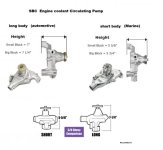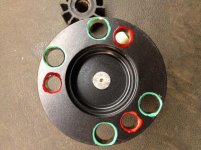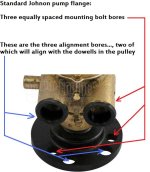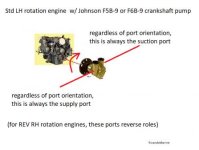The manifolds themselves are aluminum. The risers are SS.
This has always been a "complete RWC" system.
As far as differences between jet drives and stern drives, besides the drive, what is the difference? The engine cooling is functionally the same.
The jet pump provides pressurized seawater (taken from the jet stream) to the engine and pushes it through the engine.
These Jet Pump companies eliminated the Circ Pump on these engines.
Cooling was somewhat erratic and unstable.
I've read in other forums different opinions about whether the circulating pump is needed, and of course, there's a thousand opinions on that.
Regarding stern drives and engine cooling, there should be only one accurate opinion. But of course, that is my opinion.
But the only difference I can see in a SD and jet is that the sterndrive needs to be cooled.
Hey.... all due respect to you..... it's your call, I'm simply sharing my years of experience at performing Marine Work.
I understand you don't care for drive showers. But given the sketchy historical performance I've had from the stern drive pump in this boat, I'm actually suspecting my drive will be happier overall with the shower.
Why would you NOT keep the A drive seawater pump active, and simply dump the seawater over-board?
I wish I had measured the drive temp on the old setup. But just placing a hand on the gearcase, I had more heat than I thought was acceptable. Looking at the internal water flow of the unit, I see no reason that the shower won't provide as good or better heat removal for the gear housing.
The A drive seawater path pushes seawater through the gear case porting. While it may not be ideal, it has worked for Merc for years.
I think there might be more than one way to skin a cat.
Yes.....there is always more than one way to skin the cat...... but the furrier dealers will tell you that some cat skinners will offer a better pelt! 
Attempting to reproduce a bone-stock power train would cost more than the boat is worth. I am going forward on the basis that the functional aspects of a crank pump with drive shower (and the StainlessMarine components) should be adequate. Issues regarding the safety of the components are my biggest concerns at this point. I want to bring the boat up to speed regarding ignition safety in particular.
That would be "ignition source protection", and yes..... very important!
I believe the alternator has a spark control retrofit, but I've heard these might not pass safety inspections.
If by chance it is a Delco 10si with the marine screening, it will be OK.
I know the starter needs replacement.
Do yourself a favor and install a Marine version HTGR/PMGR starter motor.
With the gear reduction, the armature spins approx 3 xs faster (more torque to the flywheel) and consumes less AH during cranking.
Don't want anything going boom on me. I always go through a ritual of running the blower, opening the engine box and sniffing in the bilge before cranking,
That is a good practice.
You can go one better and use a continuous duty blower motor and let it run while the engine is running.
And say NO to the turbo or in-line blower motors. They are JUNK!
Good luck with the project.... and be safe!





